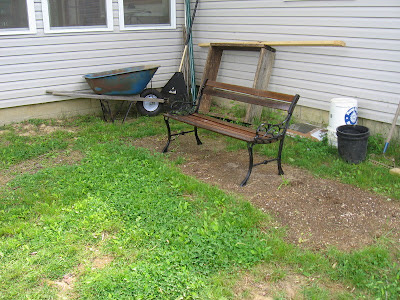So I chose to build a flower bed over the tanks. With the edging in place, a few more inches
of soil could be added and (knock on wood) something would then grow. How hard can it be?
That’s
what I’ve been working on for the past three weeks (see April 15 post for part
1). The first week I put in edging. Part of this bed had already been built into
the slope a few years ago. At that time
I just wanted to get some bushes to hide the big blue bulb. (Why couldn’t they make it green?). But the problem with the dead vegetation over
the settling tank just wasn’t going away.
Corner posts were set, string was strung between the posts, and a trench
was dug. Another course of limestone block was added to the terraced side of the bed, which was built a few years ago.
Some of the plants were relocated in the bed and new ones
put in at the edge of the bed, which is not over a tank. The internet sources advised to use only
perennials and small bushes near a septic tank, not big woody bushes. I planted mounding plants - magic carpet
spirea, rug junipers, creeping phlox – that would spill over into the areas
over the tanks.
That’s when the fun really began. I found that the dirt over the tanks was hard
Indiana clay, very little topsoil – no wonder nothing would grow. That’s when the project expanded. First the sod was scraped off and carted to a
low area next to the driveway. Then I dug out about half of the clay, about
a cubic yard, and carted it to a low spot on the pond levee and spread it
there. At that point I had three
projects going. Well I had to do something with the dirt, and I did not want to put it in a pile and move it again later.
The remaining clay was chopped up with a hoe then broken up
more with a small tiller. It’s easy to
say “chopped up with a hoe” but the reality is it took two days to break the
clay up. I hauled in two yards of
dirt/compost mix and added it to the bed.
That was mixed in by shovel and hoe then broken up again with a tiller. This is where it is now.
Some of the dirt was put against the house foundation and
graded to improve slope away from the house – a fourth project.
I
think it was Thursday morning when I tried to get out of bed and realized that work
had to stop for awhile. I plan to seed
the soil over the beds with a perennial mix and hope that something grows over
the tanks. I think there’s a light at
the end of the tunnel, the end being the end of landscaping. There’s one more project to do, a foundation
bed in the northwest corner that will make a proper setting for the bench that
I finally put together after it sat in the minibarn for five years. In comparison that will be a piece of cake.





3 comments:
Projects never seem to go as planned. It may take you a little longer to complete them all, but it will be worth it. I can't wait to see the new garden all filled in with new plantings.
Hi Mike. Very nice garden and pictures. I noticed with interest the work you are doing over your septic tank. Can I assume those are the two covers to the risers which access the tank for cleaning, and that you have a leaching field extending out adjacent to your raised beds? If so, I have a very similar arrangement and my 11" raised beds are between 10' and 30' from the edge of the septic field. Do you have similar? I believe I'm safe growing vegetables in raised beds and not directly over the septic field, but there are mixed opinions on the internet. Just wondering if you went through a similar thought process.
Good luck with your garden!
WbrookCT - I had the same concerns. I have a two tank system. First the effluent goes into a settling tank and then overflows into a dosing tank. The dosing tank has a pump with a float that pushes out the liquid into the septic field. The line goes about 30 feet directly away from the vegetable beds before splitting into 5 drain lines. From what I've read the microbial action of the soil in the drain field completely breaks down any harmful pathogens or chemicals, in fact that is where the real digestion occurs. I took up a sample of water in my dosing tank and it is close to gray water with very little odor. I have to believe that there is no chance of any E coli surviving a trip through both tanks, going through the soil microbes in the drain field then migrating at least 40 feet through clay soil to my vegetable beds. It's important to not add bleach or harsh chemicals to the waste system so the tanks can do the initial job of breaking down things. Ten feet is a little close and you may want to look at which way water flows. Does it flow downhill from the field toward the beds? It the beds are above the level of the drainpipes you should not have a problem in my opinion. If the drainage goes toward the beds you might look at putting in a drainpipe between the beds and field that will divert water away from the beds. I think that unless your soil is sandy that any liquid coming out of the pipes will migrate so slowly that any contaminants will be completely broken down.
Post a Comment